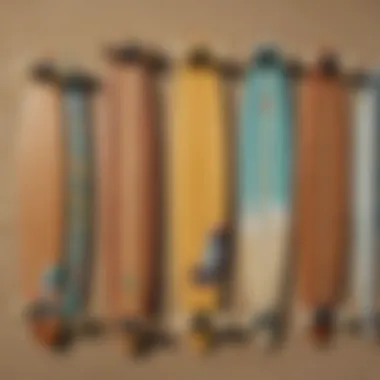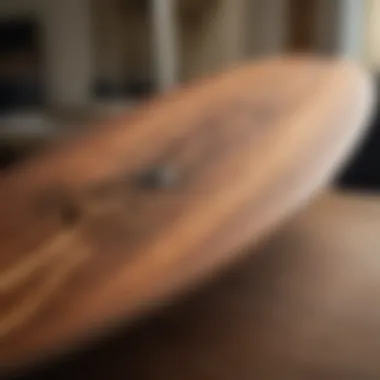The Benefits of Buying Used Longboards for Surfing


Intro
The world of longboard surfing is rich and bursting with nuances that deserve attention, especially when it comes to the second-hand market. For many seasoned surfers, using pre-owned longboards is not just a practical choice but a way to dive deeper into surf culture and history. Each board tells a story, often filled with the saltwater experiences of its previous owner. Engaging in this realm is an invitation to explore not just performance, but also a sense of community, sustainability and the unique characteristics of longboards that differ from brand-new counterparts.
In the upcoming sections, we’ll break down vital aspects of used longboard surfing. From techniques tailored for novices to tips that seasoned riders can still learn, we illustrate how this vibrant culture shapes the surfing landscape.
Techniques and Skills
Venturing into the world of used longboarding not only enables surfers to save some cash but also offers them a chance to connect with the surfing community at a more personal level. Riding a second-hand board can feel different, and understanding the fundamentals of technique is key for first-timers.
Fundamental Techniques for Beginners
For beginners, mastering the basic techniques on a longboard is essential. This journey starts with foot placement, balance, and paddling. Here are some core skills to focus on:
- Paddling: Smooth and consistent strokes will help you maintain speed and control while moving through the water.
- Pop Up: When you catch a wave, your ability to swiftly transition from lying down to standing is crucial. Practice this on land to build muscle memory.
- Balance and Stance: A low center of gravity is your best friend. Bend your knees while keeping your feet about shoulder-width apart to stay steady.
As with anything, repetition is key. Get the feel of the board—old boards might require a different touch due to wear and tear, which calls for extra attention to how they respond under your weight.
Advanced Skills for Experienced Athletes
For the more experienced surfers, navigating the waters with a used longboard can pose new challenges.
- Carving and Turning: On a longboard, finesse in carving helps maintain momentum. Knowing when to shift your weight can bring you closer to mastering elegance on the waves.
- Nose Riding: This crowd-pleaser showcases style and skill, involving walking to the front of the board while maintaining your ride.
- Vertical Maneuvers: For advanced riders, performing vertical maneuvers can showcase your skill level and board's responsiveness. This often requires a good understanding of wave dynamics and your board's limits.
As you fine-tune these skills on your used longboard, it’s essential to adjust your technique based on the board's specifications, which can vary considerably with age and wear.
Safety and Gear
When it comes to longboard surfing, safety should always take precedence. Engaging with used gear comes with its own set of considerations, making it paramount to inspect the board thoroughly before taking it out to the sea.
Essential Safety Measures in Watersports
Before you even think about hitting the waves, ensure that you’re equipped for the ride:
- Wetsuits: Depending on the climate, a well-fitting wetsuit can protect against cold water and potential scrapes.
- Leashes: Always have a leash attached to your board. Losing your board in the wave can become dangerous for others.
- Personal Flotation Devices: Though not always mandatory, having personal flotation devices can be a lifesaver in emergency situations.
Gear Reviews and Recommendations
The second-hand market for longboards is vast and diverse, with various brands to explore. Each comes with its own pros and cons. When looking to buy, consider popular brands like Hatch, Simmons, and Bing for quality longboards with history backing their designs.
Additionally, checking forums, like Reddit, and specialized groups on Facebook can unearth valuable first-hand reviews and recommendations. Engaging with the community allows for an exchange of knowledge about gear that’s worked or flopped for others, optimizing your purchasing decisions and maximizing your surfing experience.
"A used board is like a well-loved book; it might have some creases and frays but holds stories untold for those willing to read between the lines."
Foreword to Longboard Surfing
Longboard surfing, a discipline in the broader spectrum of surfing, holds a special place among water sports enthusiasts. It encapsulates a unique blend of style, grace, and skill that can only be fully appreciated within its context. Understanding the nuances of longboarding not only enhances one’s performance on the waves but also connects surfers with a rich heritage that has evolved through the ages.
Overview of Longboarding
Longboarding refers to riding longer surfboards, usually measuring over nine feet. This distinct length allows for a variety of styles, which emphasizes smooth, flowing movements rather than the rapid, aggressive maneuvers typical of shortboarding. The advantages of longboarding include greater stability and the ability to catch smaller waves, making it accessible for beginners and enjoyable for seasoned surfers.


Also, the artistry of longboarding showcases tricks and maneuvers like noseriding, where a surfer hangs the front foot over the nose of the board, creating a visually stunning spectacle. With longboarding, it’s not just about riding the wave but dancing with it, melding technique with creativity. The culture surrounding longboarding is robust, fostering a community that values tradition and innovation alike.
History of Longboard Surfing
The roots of longboard surfing go back several decades, with influences tracing back to ancient Polynesian culture, where large wooden boards were used. However, modern longboarding as we perceive it today emerged prominently in the post-World War II era, primarily on the California coast. Surfboards were once handcrafted, demonstrating beautiful artistry, and this aspect remains significant today with a resurgence of handcrafted boards tailored for individual preferences.
Notably, the 1960s served as a golden age when longboards became widely popularized through films and surf culture’s blossoming. Iconic surfers, like Greg Noll and Mickey Dora, emerged as ambassadors of the longboard lifestyle, showcasing the beauty of cruising along waves rather than chasing fast, radical movements.
In the subsequent decades, the advent of shorter, high-performance boards caused a decline in longboarding’s popularity, but the cyclical nature of trends means that longboarding has resurfaced with vigor, in part due to the sustainability movement and a growing appreciation for craft.
As surfers today seek balance and a meaningful connection with nature, longboard surfing continues to thrive, offering both a physical activity and a reflective process.
"Longboarding is not just surfing; it’s a philosophy of harmony with the ocean, an embrace of the journey over the destination."
Gaining insight into longboard surfing provides a foundation for exploring the dynamics of the used longboard market. Understanding its history and appeal is crucial for appreciating why pre-owned longboards can hold significant value in the surfing community.
The Appeal of Used Longboards
The allure of used longboards lies in their multifaceted appeal to a diverse group of surf enthusiasts, from seasoned veterans to newcomers looking to catch their first waves. This section unpacks why used longboards are so attractive, covering several significant aspects that make them worthy of consideration.
Cost-Effectiveness
One of the most straightforward arguments for investing in a used longboard is the tangible savings. New boards, especially high-quality ones, can empty your wallet faster than you can paddle out. But, by opting for a pre-owned option, you often find a similar board for a fraction of the cost. Many high-performance longboards retain their quality over time, making them a bargain when you consider the depreciation that occurs with brand new models.
- Price Range: A used longboard can range from $200 to $800, compared to a new one priced at $700 to $2,000, depending on brand and materials.
- Value for Money: Surfboards can be meticulously crafted, and even a well-loved board can have a lot to offer. You might snag a great deal on a model that has simply been out of fashion or replaced by the latest trends.
Additionally, purchasing a used board can save you money on accessories as well, since many previous owners sell their boards along with fins and leashes included, which can lead to further cost savings. For budget-conscious surfers, this cost-effectiveness represents a substantial plus.
Unique Character of Pre-Owned Boards
In a world where mass production often overshadows individuality, used longboards carry a unique charm that can be hard to come by in brand-new models. Each second-hand board tells a story, reflecting the experiences of its previous owner. This history brings character and a sense of connection to the board that new models often lack.
- Aesthetic Appeal: Many surfers appreciate the wear and tear that comes with a used board. The little dings, sun-bleached colors, or stickers from past adventures give a longboard personality. It’s akin to wearing a vintage T-shirt – the more faded it is, the more character it holds.
- Customization Potential: Pre-owned boards often can be customized more affordably than new ones. Whether you want to add a personal logo or change the color scheme, a used longboard can be a canvas where you make it truly your own without the need for a hefty investment.
For those looking to embrace a sustainable lifestyle, opting for a used longboard can also reflect values of conservation and recycling, resonating with the essence of keeping the ocean clean and green.
"A board that has been through the waves has stories to tell; it’s like bringing a piece of surf history with you every time you hit the water."
Thus, the appeal of used longboards extends far beyond mere cost. It embodies an economical choice coupled with distinctive qualities that bring a unique flavor to the surfing community.
Evaluating Used Longboards
Evaluating used longboards is a vital aspect for anyone looking to navigate the second-hand market. It’s not just about finding a surfboard that fits your style or taste; it’s also about ensuring you make a sound investment. The right board can enhance your experience on the waves, while a poorly chosen one might leave you high and dry. Therefore, understanding the elements involved in evaluating used longboards can help you save money, maintain performance, and validate your choice within the surfing community.
Key Considerations in Selection
When it comes to selecting a used longboard, there are several key factors to consider:
- Condition: Look for signs of major wear like deep scratches, dings, or deformations. A board that shows more damage than character could be a lemon.
- Type of Riding: Consider how you ride—do you prefer cruising or doing tricks? Your style can dictate the board characteristics, including size and shape.
- Dimensions: Different dimensions can influence feel and performance. A wider board offers stability, while a longer board can give you more glide.
- Price Range: Setting a budget is essential. Research similar models to gauge appropriate pricing and determine if you’re getting bang for your buck.
“It’s only as good as you make it” often holds true in surfing. Buying a used longboard can involve compromise, so know your priorities.
Understanding Wear and Tear


Like it or not, the ocean isn’t gentle with surfboards. Each trip out can take its toll, so it’s crucial to understand what specific types of wear and tear might be critical:
- Delamination: This occurs when the top layer separates from the foam core. Grab the nose of the board and try twisting it; if it flexes easily, you could be looking at a delaminated product.
- Fin Damage: Inspect the fins for cracks or missing pieces. Fins can greatly affect your board’s handling.
- Riptide & Sun Exposure: Boards left in the sun can become brittle. Check for signs of discoloration or fading, as they might hint at sun damage.
A well-maintained longboard can last many years, but understanding these nuances can aid in your decision-making process.
Assessing Brand Reputation
Let’s face it: not all brands are cut from the same cloth. The standing of a manufacturer can significantly influence the quality of the board you're considering. Here’s how to assess brand reputation:
- Research and Reviews: Look for user reviews on forums like Reddit or Facebook groups. Enthusiasts often share their experiences with specific brands.
- Warranty and Return Policy: Reputable brands often provide warranties or flexible return policies, indicating confidence in their products.
- Community Recommendations: Ask fellow surfers or local shops for their thoughts. Word of mouth can reveal valuable insights that online reviews may not.
In surfing, much like life, the name can mean quite a bit—ensuring you’re looking at established brands may prevent buyer’s remorse later down the line.
Ultimately, evaluating used longboards requires a careful balance of attention to detail, personal preference, and community insight. By considering all these factors, you can make a more informed selection and enjoy your surfing adventures with confidence.
Technical Aspects of Longboard Surfing
Understanding the technical aspects of longboard surfing is crucial for both novice and seasoned surfers. These elements not only influence performance but also contribute to the enjoyment and overall experience that comes with riding waves. When diving into a pre-owned longboard, practitioners must consider factors like shapes, fins, and materials; each will have an impact on how the board responds in various wave conditions.
Board Shapes and Designs
The shape of a longboard affects how it glides over the water and responds to different surf conditions. From the classic nose rider to more contemporary models, each shape has its own unique flair and function. For instance, a wider nose allows for smooth noserides, while a tapered tail provides enhanced maneuverability.
- Classic Nose Rider: This shape accommodates smooth, graceful moves, commonly favored by surfers who enjoy long, leisurely rides.
- Squash Tail: A versatile choice known for its ability to pivot quickly, making it suitable for both small and larger waves.
- Pin Tail: Often seen in performance boards, this design excels in holding during turns, ideal for overhead waves.
Choosing a shape that aligns with one's surfing style and the prevailing conditions is paramount. Pre-owned boards often wear traces of their history, revealing how previous owners utilized them. A well-loved classic might have more character but could also feature repairs that affect performance.
Fin Setup Variations
Fins play a significant role in a longboard’s stability, control, and speed. The arrangement and size of fins can drastically change how the board behaves on water. Most longboards come with single fin setups, which provide a smooth ride suited for traditional longboarding techniques. However, some surfers prefer a thruster setup for faster, more agile performances.
When shopping for used longboards, it’s worth checking:
- Fin Type: Different materials and shapes impact ride dynamics.
- Futures vs. FCS: Compatibility with your fin system can limit or enhance options for customization.
Even minor changes to fin setups can significantly alter a longboard’s capabilities. A board purchased second-hand with a specific fin design may have been optimized for a particular style that might not align with your preferences.
Material Choices
The materials used in a longboard deeply influence its durability, weight, and how it flexes or snaps in the waves. Most boards are built with either traditional polyurethane foam or more modern epoxy materials.
- Polyurethane Foam: Generally heavier, but offers a classic feel and robust performance. Often, vintage boards will be made from this material.
- Epoxy: Lighter and more buoyant, larger boards made from epoxy are often preferred for long distances.
While browsing through used longboards, consider the signs of stress and previous repairs. Fractures in the foam or delamination in epoxy boards can hint at longevity issues. Knowing what material improves stability and handling is vital, especially for those looking to improve their surfing game.
If you’re keen on optimizing your ride, remember that the interplay between shape, fin setups, and materials might be the difference between cruising smoothly and battling with the waves.
The Second-Hand Market for Longboards
The world of longboard surfing is not just about riding waves. It's also a vibrant community that extends beyond the ocean. Within this community exists a thriving second-hand market for longboards, which serves several important roles. It is here that surfers can find unique boards, often with character that new models lack. The resale market not only cultivates a sense of sustainability but also fosters connections among enthusiasts.


Popular Platforms for Resale
When looking to navigate the second-hand market, knowing where to search is crucial. Some of the most popular platforms for buying and selling used longboards include:
- Facebook Marketplace: A favorite among local buyers and sellers. Here, surfers can find listings from nearby enthusiasts, making it easy to inspect the board before buying.
- eBay: This global platform offers a wide variety of boards, often at competitive prices. It’s also a great spot for sellers aiming to reach a larger audience.
- Reddit: The surfing subreddit often has dedicated threads for buying and selling gear. Engaging with this community can lead to unexpected finds and good deals.
- Craigslist: A classic in the classifieds scene, Craigslist allows for regional searches, which can broaden your options for second-hand boards in your area.
"The second-hand market isn't just about the board itself; it's about sharing stories and experiences that each one holds."
These platforms not only offer convenience but also enable buyers to gauge the integrity of the seller. Each one has its own vibe and crowd, so trying a few could yield the best results.
Community and Resale Culture
The resale culture surrounding longboards is as rich as the sport itself. Many surfers believe that purchasing a used board is not only economical but also supports a culture of sharing and sustainability. This culture thrives on trust and relationships within the surfing community.
Surfboards, especially longboards, often tell stories of their past – the waves they’ve ridden and the hands they've passed through. This connection to history is appealing to many. Furthermore, buying pre-owned gear prevents waste and contributes to a greener ethos in a sport that often faces criticism for its environmental footprint.
In addition, sharing information about where to find quality used longboards helps the community grow. Surfers often discuss their findings on social media or forums, adding to the collective knowledge. This camaraderie further emphasizes that surfing is not just an individual pursuit; it’s a shared journey and the second-hand market is a vital part of it.
As more surfers discover the benefits of buying used boards, the environment grows positively impacted and community bonds strengthen. By recycling equipment, surfers create a more sustainable culture around what they love, allowing for fresh experiences without adding to the excess.
Engaging in this market can lead to unexpected friendships and help foster a deeper respect for the craft of surfing, underlined by an ethos that values history, community, and sustainability.
Environmental Impact of Used Longboards
The environmental footprint of surfing gear has come under scrutiny as more individuals seek to reduce their ecological impact. This factor is especially relevant for longboarders who are not only passionate about riding waves but also care about preserving the oceans and surf spots. Understanding the dynamics behind used longboards offers significant insights into sustainability, resource conservation, and community responsibility within the surf culture. Embracing pre-owned surfboards can lead to a noticeable reduction in environmental strain, fostering a mindset that values longevity over consumerism.
Sustainability Considerations
Sustainability has become a buzzword across various industries, and for good reason. In the case of longboard surfing, the sustainability of using used boards lies in several factors:
- Resource Conservation: Manufacturing new boards often relies on materials like fiberglass and epoxy, which require a considerable amount of energy and resources. By opting for second-hand options, surfers reduce the demand for new production, thereby conserving natural resources and reducing industrial pollution.
- Lifecycle Emphasis: A used longboard comes with a story—often previously loved and cared for. This notion breathes life into the concept of extending a product's lifecycle, engaging surfers in practices that value longevity over disposability. Investing in used boards encourages a culture of stewardship.
- Community Support: Buying from local surf shops or fellow surfers stimulates the local economy and fosters community ties. This connection underscores the value of shared experiences and embraces the surfing community's collaborative essence.
Purchasing a used longboard therefore becomes an act of nurturing the environment while supporting local economies—a win-win!
Reducing Waste in Surfing
Shifting towards used longboards plays a critical role in waste reduction. Here’s a look at the various ways this can help:
- Less Landfill Contribution: Each year, countless surfboards end up in landfills, contributing harmful practices to the environment. By opting for second-hand, surfers help curtail the disposal of functional boards, lessening overall waste.
- Recycling and Upcycling: Many surfboard manufacturers now engage in recycling programs, turning old boards into new products. When surfers buy used boards instead of new ones, they indirectly encourage such initiatives, promoting a cycle of recycling that benefits the environment.
- Reduction of Production Waste: The manufacturing process is resource-intensive. From raw materials to excess leftover, new production leaves a significant carbon footprint. Choosing used reduces the need for new creations, thus minimizing the waste generated by production.
"Embracing used longboards isn’t just about saving money; it’s about nurturing our planet, community, and sport."
Finale
The world of used longboard surfing offers a unique lens through which to explore not just the sport itself, but the broader themes of community, sustainability, and personal expression. As this article has shown, opting for pre-owned boards isn't merely a matter of economy; it reflects a deeper commitment to an evolving surf culture where character and individuality take precedence.
Summary of Key Points
To encapsulate the discussion, let’s revisit the significant points that underscore the dynamics of used longboards:
- Cost-Efficiency: Purchasing second-hand longboards allows surfers to access quality equipment without straining their wallet. A vintage board often comes with a price tag that’s easier to manage compared to brand-new offerings.
- Character and History: Each used longboard carries a story, echoing the adventures of those before us. From dings and scratches to faded colors, these boards embody a rich surfing narrative that new boards can’t replicate.
- Environmental Benefits: By supporting the resale market, surfers contribute to sustainability efforts. Opting for used gear reduces waste and helps in the circular economy by extending the lifespan of surf equipment.
- Knowledge and Experience: Buying a second-hand board provides an opportunity to engage with the surf community. Conversations with previous owners can offer insights into particular board types and local surf conditions.
- Trends in Resale Market: Platforms like Reddit, Facebook Marketplace, and specialized surf forums have transformed the way surfers buy and trade used equipment, introducing a level of camaraderie within the sphere of surfing.
The Future of Used Longboards in Surf Culture
Looking ahead, the future of used longboards seems ripe with potential. As younger generations become increasingly conscious of their environmental footprint, the appeal of pre-owned surf equipment is likely to grow. The integration of online platforms fostering community exchange will enhance accessibility.
Furthermore, as the chill vibe of longboard surfing continues to blend with a commitment to sustainability, one can expect more surf brands to dive into the repair and refurbishing of older boards, extending their discoverable lives.
"The ocean is a canvas for every surfer's story, whether it's painted with new boards or the weathered grain of a used longboard."















